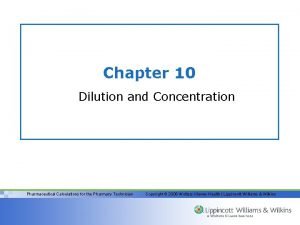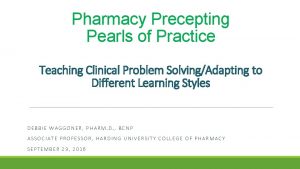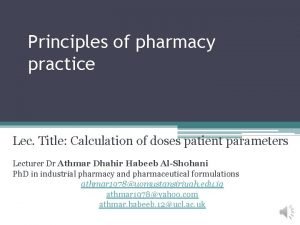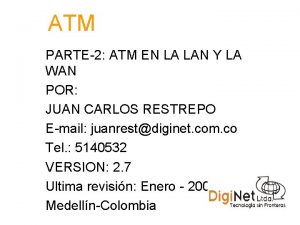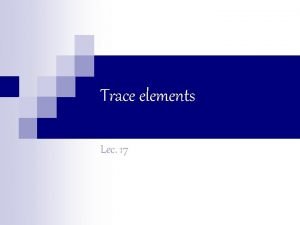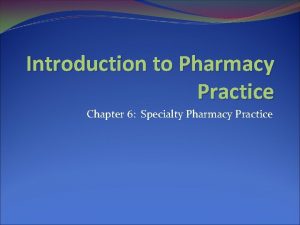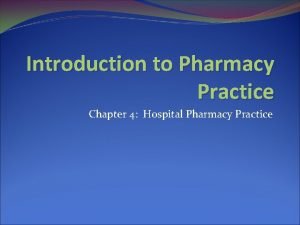Principles of pharmacy practice Lec 1 Lec Dr

















- Slides: 17

Principles of pharmacy practice Lec 1 Lec Dr Athmar Dhahir Habeeb Ph. D in industrial pharmacy and pharmaceutical formulations

Introduction • Pharmaceutical calculations is the area of study that applies the basic principles of mathematics to the preparation and safe and effective use of pharmaceuticals • Success in performing pharmaceutical calculations is based on: • an understanding of the purpose or goal of the problem; • an assessment of the arithmetic process required to reach the goal • implementation of the correct arithmetic manipulations.

The following steps are suggested in addressing the calculations problems Step 1. Take the time necessary to carefully read and thoughtfully consider the problem prior to engaging in computations. An understanding of the purpose or goal of the problem and the types of calculations that are required will provide the needed direction and confidence. Step 2. Estimate the dimension of the answer in both quantity and units of measure (e. g. , milligrams) to satisfy the requirements of the problem. Step 3. Perform the necessary calculations using the appropriate method both for efficiency and understanding Step 4. Before assuming that an answer is correct, the problem should be read again and all calculations checked. Step 5. Consider the reasonableness of the answer in terms of the numerical value, including the proper position of a decimal point, and the units of measure.

Fundamentals of Pharmaceutical Calculations • Upon successful completion of this chapter, the student will be able to: • Convert common fractions, decimal fractions, and percentages to their corresponding equivalent expressions and apply each in calculations. • Utilize exponential notations in calculations. • Apply the method of ratio and proportion in problem-solving.

Common and Decimal Fractions Common fractions are portions of a whole, expressed at 1⁄3, 7⁄8, and so forth. They are used only rarely in pharmacy calculations nowadays. It is recalled, that when adding or subtracting fractions, the use of a common denominator is required. The process of multiplying and dividing with fractions is recalled by the following examples.

Example: If the adult dose of a medication is 2 teaspoonful (tsp. ), calculate the dose for a child if it is 1⁄4 of the adult dose. Example: If a child’s dose of a cough syrup is 3⁄4 teaspoonful and represents 1⁄4 of the adult dose, calculate the corresponding adult dose.

A decimal fraction • NOTE: When common fractions appear in a calculations problem, it is often best to convert them to decimal fractions before solving. • Decimal fraction is a fraction with a denominator of 10 or any power of 10 and is expressed decimally rather than as a common fraction. Thus, 1/10 is expressed as 0. 10 and 45/100 as 0. 45

• To convert a common fraction to a decimal fraction, divide the denominator into the numerator. To convert a decimal fraction to a common fraction, express the decimal fraction as a ratio and reduce.

Common arithmetic symbols used in pharmaceutical calculations Percent • The term percent and its corresponding sign, %, mean ‘‘in a hundred. ’’ So, 50 percent (50%) means 50 parts in each one hundred of the same item • Common fractions maybe converted to percent by dividing the numerator by the denominator and multiplying by 100. • Decimal fractions may be converted to percent by multiplying by 100.

Ratio • The relative magnitude of two quantities is called their ratio. • Since a ratio relates the relative value of two numbers, it resembles a common fraction except in the way in which it is presented. • Whereas a fraction is presented as, for example, 1⁄2, a ratio is presented as 1: 2 and is not read as ‘‘one half, ’’ but rather as ‘‘one is to two. ’’ • All the rules governing common fractions equally apply to a ratio. Of particular importance is the principle that if the two terms of a ratio are multiplied or are divided by the same number, the value is unchanged, the value being the quotient of the first term divided by the second. • For example, the ratio 20: 4 or 20⁄4 has a value of 5; if both terms are divided by 2, the ratio becomes 10: 2 or 10⁄2, again the value of 5.

• When two ratios have the same value, they are equivalent. • An interesting fact about equivalent ratios is that the product of the numerator of the one and the denominator of the other always equals the product of the denominator of the one and the numerator of the other; that is, the cross products are equal:

• We discover further that the numerator of the one fraction equals the product of its denominator and the other fraction • And the denominator of the one equals the quotient of its numerator divided by the other fraction:

An extremely useful practical application of these facts is found in PROPORTION • A proportion is the expression of the equality of two ratios. It may be written in any one of three standard forms: • Each of these expressions is read: a is to b as c is to d, and a and d are called the extremes (meaning ‘‘outer members’’) and b and c the means (‘‘middle members’’).

Example: If 3 tablets contain 975 milligrams of aspirin, how many milligrams should be contained in 12 tablets? If 3 tablets contain 975 milligrams of aspirin, how many tablets should contain 3900 milligrams?

Example: If 12 tablets contain 3900 milligrams of aspirin, how many milligrams should 3 tablets contain? If 12 tablets contain 3900 milligrams of aspirin, how many tablets should contain 975 milligrams?

• Proportions need not contain whole numbers. If common or decimal fractions are supplied in the data, they may be included in the proportion without changing the method. • For ease of calculation, it is recommended that common fractions be converted to decimal fractions prior to setting up the proportion. • Example: If 30 millilitres (m. L) represent 1⁄6 of the volume of a prescription, how many millilitres will represent 1⁄4 of the volume?

Interpretation of Prescriptions and Medication Orders Prescription • is an order for medication issued by a physician, dentist , or other properly licensed medical practitioner. • A prescription designates a specific medication and dosage to be prepared by a pharmacist and administered to a particular patient. • A prescription is usually written on preprinted forms containing the traditional symbol (meaning ‘‘recipe, ’’ ‘‘take thou, ’’ or ‘‘you take’’), name, address, telephone number, and other pertinent information regarding the physician or other prescriber. • In addition, blank spaces are used by the prescriber to provide information about the patient, the medication desired, and the directions for use.
 Consultation skills for pharmacy practice
Consultation skills for pharmacy practice Pharmacy concentration and dilution practice problems
Pharmacy concentration and dilution practice problems Peter bai
Peter bai Consultation skills for pharmacy practice
Consultation skills for pharmacy practice Pharmacy practice pearls
Pharmacy practice pearls Gpp in pharmacy
Gpp in pharmacy 7 principles of pharmacy
7 principles of pharmacy Accounting for pharmacies
Accounting for pharmacies Scoreboard architecture
Scoreboard architecture 11th chemistry thermodynamics lec 13
11th chemistry thermodynamics lec 13 Lec ditto
Lec ditto Lec scoreboard
Lec scoreboard Componentes del lec
Componentes del lec 11th chemistry thermodynamics lec 10
11th chemistry thermodynamics lec 10 Elements lec
Elements lec August lec 250
August lec 250 Underground pipeline for irrigation
Underground pipeline for irrigation Lec material
Lec material

